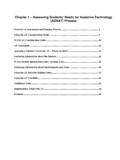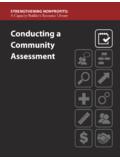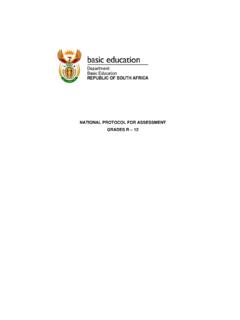Transcription of Content Sheet 12-1: Overview of Personnel Management
1 Personnel Module 12 Content Sheet 1 Content Sheet 12-1: Overview of Personnel Management Role in quality Management system Personnel are the most important laboratory resource. Critical to the implementation of the quality Management system are people who possess integrity and recognize the importance of their work and participate in continuous improvement. Laboratorians are important partners in healthcare. Overview of the process Recruiting and retaining qualified staff is essential to laboratory quality. Failure to check the education qualifications and references for a new hire can lead to problems in the future.
2 As a Laboratory director it is important to: Hire an appropriate number of staff to cover workload. Verify that items on the job application are correct. Develop complete and thorough job descriptions for each employee. Train each employee in their specific duties. Provide orientation for new employees. Even with a credible background, differences between laboratories are common, so a manager needs to assure new employees have adequate orientation and training. Conduct and record competency assessments on all Personnel . It is Management s responsibility to verify that trained employees are sufficiently competent to do their work.
3 Provide opportunities for continuing education; new techniques or updates for existing methods can be introduced using continuing education courses. Conduct annual employee performance appraisals. OrganizationPersonnelEquipmentPurchasing & InventoryProcess ControlInformation ManagementDocuments& RecordsOccurrence ManagementAssessmentProcess ImprovementCustomer ServiceFacilities & SafetyOrganizationOrganizationPersonnelP ersonnelEquipmentEquipmentPurchasing & InventoryPurchasing & InventoryProcess ControlInformation ManagementInformation ManagementDocuments& RecordsDocuments& RecordsOccurrence ManagementOccurrence ManagementAssessmentProcess ImprovementProcess ImprovementCustomer ServiceCustomer ServiceFacilities & SafetyFacilities & SafetyPersonnel Module 12 Content
4 Sheet 2 As a Quality manager it is necessary to: provide employees with orientation and training; keep track of employee records and make sure they are confidential; include policies relevant to Personnel in the Quality Manual. As a Laboratorian it is important to: participate in training and continuing education opportunities; request training that may be needed as job responsibilities increase; maintain records of personal professional development. Importance of motivation Success or failure depends on the knowledge and skills of the people in the laboratory, and their commitment and motivation to do the job to perform tasks as described in the job description.
5 Motivated employees are more likely committed to their work. Elements of motivation vary for different people: some respond to concrete rewards such as bonuses and praise; some respond best to flexible work schedules that fit their responsibilities to home and children; most respond to recognition, and feeling that they are an integral part of the health- care team. The manager can motivate the team by emphasizing that everyone s job is important; whether it is performing testing, collecting specimens, making reagents, or managing the laboratory. Retention of staff Migration and turn-over of staff have been described as major challenges in many countries.
6 Apart from economic factors, the lack of good working environment and improper Management practices can contribute to loss of staff. A good Personnel Management program can contribute to the retention of staff. Personnel Module 12 Content Sheet 3 Content Sheet 12-2: Recruitment and Orientation Personnel qualifications and job description Management must establish appropriate Personnel qualifications for all positions in the laboratory. These should include requirements for education, skills, knowledge, and experience. When defining qualifications, keep in mind any special skills and knowledge that are needed such as language, information technology, and biosafety.
7 Job descriptions give a clear and accurate picture of responsibilities and authorities for each staff position. Job descriptions should: lay out all activities and tasks that should be performed; specify responsibilities for conducting testing and implementing the quality system (policies and activities); reflect the employee s background and training; be kept current and be available for all people working in the laboratory. Job descriptions should be competency-based and reflect any skills needed. The requirements for each staff position may vary depending on the size of the laboratory and complexity of testing services offered.
8 For example, in small laboratories with limited Personnel , staff may have many responsibilities and perform many tasks, whereas in larger laboratories with more Personnel , staff may be more specialized. Remember, not only are clear job descriptions a guideline, but they can be used to formally assess Personnel competency. Orientation Orientation is the process of introducing a new staff member to the new work environment and to his/her specific tasks or duties. Nothing is more frustrating to an employee than not knowing where to find the necessary resources. Orientation is different from training.
9 Personnel Module 12 Content Sheet 4 Orientation of laboratory Personnel should include the following aspects. General orientation: o A tour of the work place and introduction to all Management and staff. o Information about: how the organization fits into the medical community and/or the public health system; key Personnel and lines of authority; the laboratory interaction with both users and customers of the laboratory; the policies and procedures regarding facilities and safety. Personnel policies: o ethics o confidentiality o employee benefits o work schedules. An employee handbook that outlines the policies of the organization and information about the laboratory quality system.
10 A copy of the employee s job description and a detailed review of its contents. Employees should be provided with an Overview of Standard Operating Procedures (SOP). A checklist that addresses each aspect of the orientation is important. Ask employees to initial and date the checklist to document discussion of each topic (Annex 12-A). Personnel Module 12 Content Sheet 5 Content Sheet 12-3: Competency and Competency assessment Definitions Competency is defined as the application of knowledge, skills, and behaviors used in performing specific job tasks (ISO 10015:1999).1 Accurate laboratory test results depend on staff competent in performing a range of procedures that occur throughout the entire examination process.


















